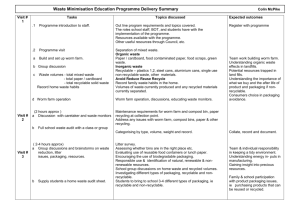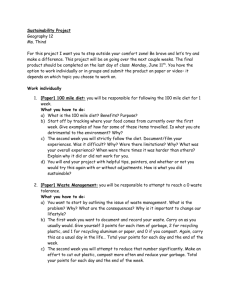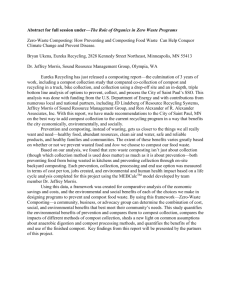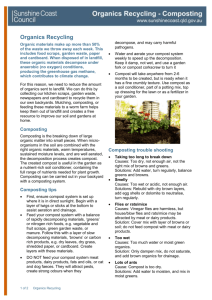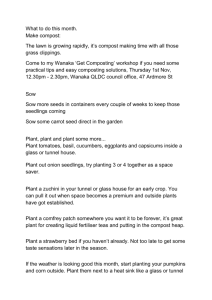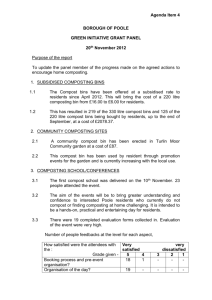File - Reduce, Reuse, Recycle
advertisement
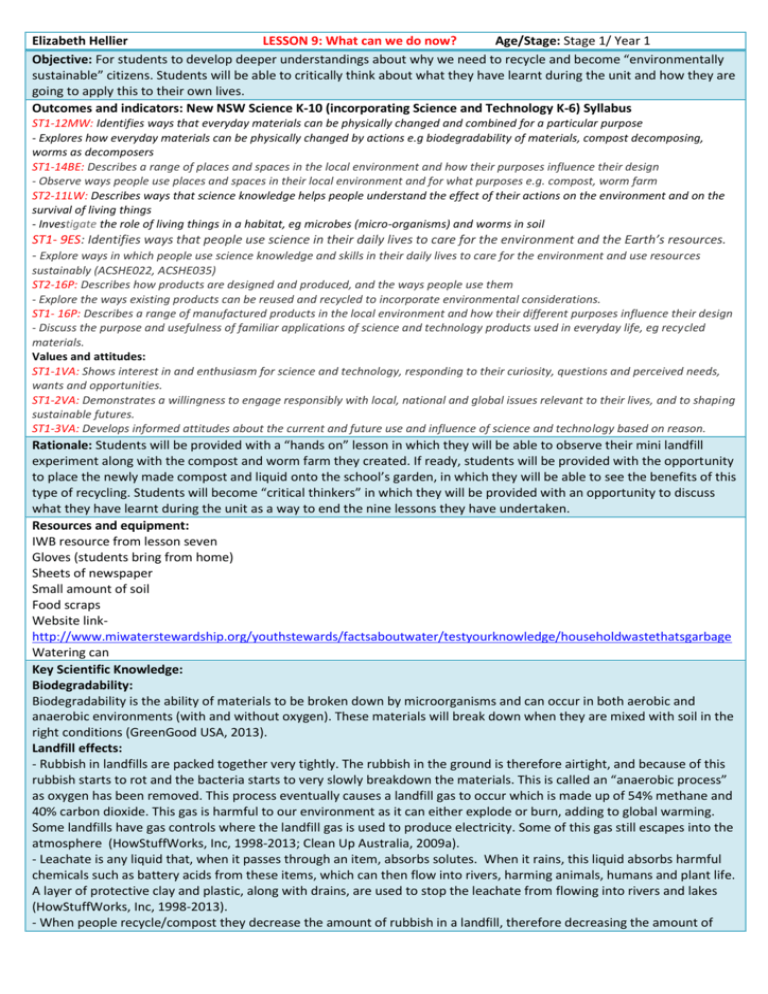
Elizabeth Hellier LESSON 9: What can we do now? Age/Stage: Stage 1/ Year 1 Objective: For students to develop deeper understandings about why we need to recycle and become “environmentally sustainable” citizens. Students will be able to critically think about what they have learnt during the unit and how they are going to apply this to their own lives. Outcomes and indicators: New NSW Science K-10 (incorporating Science and Technology K-6) Syllabus ST1-12MW: Identifies ways that everyday materials can be physically changed and combined for a particular purpose - Explores how everyday materials can be physically changed by actions e.g biodegradability of materials, compost decomposing, worms as decomposers ST1-14BE: Describes a range of places and spaces in the local environment and how their purposes influence their design - Observe ways people use places and spaces in their local environment and for what purposes e.g. compost, worm farm ST2-11LW: Describes ways that science knowledge helps people understand the effect of their actions on the environment and on the survival of living things - Investigate the role of living things in a habitat, eg microbes (micro-organisms) and worms in soil ST1- 9ES: Identifies ways that people use science in their daily lives to care for the environment and the Earth’s resources. - Explore ways in which people use science knowledge and skills in their daily lives to care for the environment and use resources sustainably (ACSHE022, ACSHE035) ST2-16P: Describes how products are designed and produced, and the ways people use them - Explore the ways existing products can be reused and recycled to incorporate environmental considerations. ST1- 16P: Describes a range of manufactured products in the local environment and how their different purposes influence their design - Discuss the purpose and usefulness of familiar applications of science and technology products used in everyday life, eg recycled materials. Values and attitudes: ST1-1VA: Shows interest in and enthusiasm for science and technology, responding to their curiosity, questions and perceived needs, wants and opportunities. ST1-2VA: Demonstrates a willingness to engage responsibly with local, national and global issues relevant to their lives, and to shaping sustainable futures. ST1-3VA: Develops informed attitudes about the current and future use and influence of science and technology based on reason. Rationale: Students will be provided with a “hands on” lesson in which they will be able to observe their mini landfill experiment along with the compost and worm farm they created. If ready, students will be provided with the opportunity to place the newly made compost and liquid onto the school’s garden, in which they will be able to see the benefits of this type of recycling. Students will become “critical thinkers” in which they will be provided with an opportunity to discuss what they have learnt during the unit as a way to end the nine lessons they have undertaken. Resources and equipment: IWB resource from lesson seven Gloves (students bring from home) Sheets of newspaper Small amount of soil Food scraps Website linkhttp://www.miwaterstewardship.org/youthstewards/factsaboutwater/testyourknowledge/householdwastethatsgarbage Watering can Key Scientific Knowledge: Biodegradability: Biodegradability is the ability of materials to be broken down by microorganisms and can occur in both aerobic and anaerobic environments (with and without oxygen). These materials will break down when they are mixed with soil in the right conditions (GreenGood USA, 2013). Landfill effects: - Rubbish in landfills are packed together very tightly. The rubbish in the ground is therefore airtight, and because of this rubbish starts to rot and the bacteria starts to very slowly breakdown the materials. This is called an “anaerobic process” as oxygen has been removed. This process eventually causes a landfill gas to occur which is made up of 54% methane and 40% carbon dioxide. This gas is harmful to our environment as it can either explode or burn, adding to global warming. Some landfills have gas controls where the landfill gas is used to produce electricity. Some of this gas still escapes into the atmosphere (HowStuffWorks, Inc, 1998-2013; Clean Up Australia, 2009a). - Leachate is any liquid that, when it passes through an item, absorbs solutes. When it rains, this liquid absorbs harmful chemicals such as battery acids from these items, which can then flow into rivers, harming animals, humans and plant life. A layer of protective clay and plastic, along with drains, are used to stop the leachate from flowing into rivers and lakes (HowStuffWorks, Inc, 1998-2013). - When people recycle/compost they decrease the amount of rubbish in a landfill, therefore decreasing the amount of methane gas and leachate which is formed (HowStuffWorks, Inc, 1998-2013). Benefits of composting: Composting produces a brown material called, “humus”, which acts as a natural fertilizer for your plants. This assists in improving your soil, plant growth and prevention from certain insects and diseases (Clean Up Australia, 2009a). What is compost? Composting is the process of decomposition, in which microorganisms (bacteria or fungi) feed of the organic matter (made up or carbon and nitrogen) and break it down, producing carbon dioxide, water (also known as leachate), heat and the compost itself, which is also known as “humus” (Daily Dump, 2013). When water is added, the heat causes evaporation in which steam rises from the compost (Rodale Inc, 2013). It can take up anywhere between 6 weeks and 6 months to create compost, depending on how well it its looked after (Clean Up Australia, n.d). Worm farm: Worm farming is a type of composting in which worms are used to break down food waste into rich soil and liquid social conditioners. The worms eat the food scraps in which produce both a liquid and worm castings. The liquid is formed by the water placed into the worm farm, which flows to the bottom level and drips out of the tap and into a bucket. Worm castings are the food waste in which has been digested by the worms (Department of Industry, 2013). Both these items help plants thrive and gain nutrients (Clean Up Australian, 2009b). Layout of the lesson: This lesson could be completed during a morning session (one to two hours) Introduction to lesson: Students will be asked to get their mini landfills they made in lesson seven and come sit on the floor in a large circle. Sheets of newspaper will be layed out in the middle of the circle and students will be asked to pour out the contents of their mini landfill. Time will be provided to students to look through their landfills using gloves provided. A discussion will take place after, in which the table made on the IWB (Refer to lesson seven’s IWB resource) of the student’s hypotheses will be shown. Students will be able to discuss whether their hypothesis was correct and show the class the materials they buried. Students will look to see if any of their items have started to breakdown, which means they are biodegradable and the items that did not breakdown are not biodegradable. Students will then put their mini landfills back in the bottle to leave them for a longer time period. The newspaper will be recycled and a discussion will take place as to what students have learnt from the experience in regards to recycling. The teacher will show some interesting statistics about the amount of time a material will take to breakdown in a landfill. Statistics can be found on the following website: http://www.miwaterstewardship.org/youthstewards/factsaboutwater/testyourknowledge/householdwastethatsgarbage Observing compost and worm farm: (Clean Up Australia, 2009b) Students will be asked to predict what they think the compost and worm farm will look like before they are taken outside to observe both. If compost and worm farm are ready, ask students to take turns (gloves will be worn) to harvest the worm castings and put the compost and liquid onto the school garden. (To know if worm farm ready, there will be little or no bedding and will look brown). To harvest worm castings: (Nominate students to help you do this) - Move contents of worm farm to one side and add fresh bedding and food to other side. The worms will slowly move from the old compost to the fresh bedding and food (this will take a few days) in which then you can move the worm free compost and add to soil. *Students who are looking after worm farm for that week, may come and do this. - Explain to students what is happening, the benefits and importance of what they are doing. - Does the compost pile feel hot? Can you see any steam? - Can you see any of the materials that were placed in the tumbler left? What materials still need to breakdown? - What does the compost look like? Smell like? - What does the worm farm/worm castings/liquid look like? - Was your prediction correct? End of lesson: Hold a class brainstorm and discussion about what the students are going to do now, after participating in the recycling unit. - What stood out? - What will you do at home/school/ community? - What is something you will take away from the unit? Modifications: Extension: Teacher can facilitate students in looking through To extend this lesson, students can create posters to place around their landfills, using open-ended questions to ask the school, which demonstrate the benefits of recycling, composting them about the materials they buried. or worm farming. References: Clean Up Australia. (n.d). Composting. Retrieved 28th October, 2013 from http://www.cleanup.org.au/au/LivingGreener/composting.html Clean Up Australia. (2009a). Composting fact sheet. Retrieved 28th October, 2013 from http://www.cleanup.org.au/PDF/au/cleanupaustralia_factsheet_composting.pdf Clean Up Australia. (2009b). Worm farming fact sheet. Retrieved 28th October, 2013 from http://www.cleanup.org.au/PDF/au/cua_wormfarming_fact_sheet.pdf DailyDump. (2013). Basics of decomposition. Retrieved 28th October, 2013 from http://www.dailydump.org/decomposition Department of Industry. (2013). Start a worm farm. Retrieved 28th October, 2013 from http://www.livinggreener.gov.au/waste/reducing-and-recycling/kitchen-foodwaste/start-worm-farm GreenGood USA. (2013). Biodegradable definition. Retrieved 28th October, 2013 from http://www.greengood.com/terms_to_know/biodegradable_definitions.htm HowStuffWorks, Inc. (1998-2013). How landfills work. Retrieved 28th October, 2013 from http://science.howstuffworks.com/environmental/green-science/landfill.htm Michigan Water Stewardship Program. (2013). Household waste- That’s garbage!. Retrieved October 21st, 2013 from http://www.miwaterstewardship.org/youthstewards/factsaboutwater/testyourknowled ge/householdwastethatsgarbage NSW Board of Studies. (2012). Science K-10 (Incorporating science and technology K-6). Retrieved October 19th, 2013 from http://syllabus.bos.nsw.edu.au/science/science-k10/ Rodale, Inc. (2013). How to build a compost pile. Retrieved 28th October, 2013 from http://www.organicgardening.com/learn-and-grow/how-build-compost-pile



